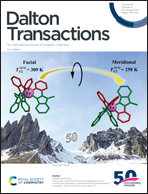A weakly luminescent Tb-MOF-based “turn-on” sensor for the highly selective and sensitive sensing of an anthrax biomarker†
Abstract
Bacillus anthracis is an extremely dangerous bacterium that is associated with high morbidity and mortality. 2,6-Pyridine dicarboxylic acid (DPA) is a major biomarker of Bacillus anthracis, and it is of great significance to be able to detect DPA in a rapid, efficient, and sensitive way. Herein, a 3D network metal–organic framework (Tb-MOF) with excellent thermal and water stability was synthesized. Tb-MOF could be used to selectively detect DPA via green fluorescence recovery with a fluorescence intensity enhancement factor of 103. In addition, due to the high detection sensitivity (a detection limit of 2.4 μM) and excellent anti-interference abilities, Tb-MOF was less affected by environmental factors when compared with a “turn-off”-response luminescence sensor; it can be employed as a promising “turn-on” luminescence sensor for DPA in the future. Finally, quantum calculations showed that a large energy difference appeared between the 5D4 level of Tb3+ and the first excited triplet energy level of H2-DHBDC2−, which was the reason that the complex did not show characteristic Tb3+ emission.



 Please wait while we load your content...
Please wait while we load your content...